26th Space Aggressor Squadron
The 26th Space Aggressor Squadron is a unit of the United States Air Force located at Schriever Air Force Base, Colorado. It is part of the 926th Group and is the reserve associate of the 527th Space Aggressor Squadron.[4]
| 26th Space Aggressor Squadron | |
|---|---|
 Crew group shot from the 26th Aggressor Squadron[note 1] | |
| Active | 1917–1919; 1921–1924; 1930–1948; 1948–1968; 1973–1990; 2003–present |
| Country | |
| Branch | |
| Type | Squadron |
| Role | Aggressor (Space) |
| Part of | Air Force Reserve Command |
| Garrison/HQ | Schriever AFB, Colorado |
| Motto(s) | Resistere Futile Est Latin Resistance is Futile[1] |
| Engagements | World War I Southwest Pacific Theater[1] |
| Decorations | Distinguished Unit Citation Navy Presidential Unit Citation Air Force Outstanding Unit Award[1] |
| Commanders | |
| Current commander | Lt Col Frank Kincaid |
| Notable commanders | Major Raynal Bolling |
| Insignia | |
| 26th Space Aggressor Squadron emblem | 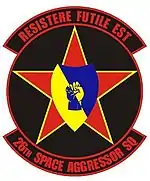 |
| 26th Space Aggressor Squadron emblem (approved 26 June 2003)[1] | 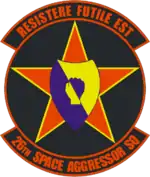 |
| Patch with 26th Tactical Fighter Training Aggressor Squadron emblem | 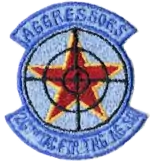 |
| 26th Attack Squadron emblem (approved 15 February 1924)[2] | 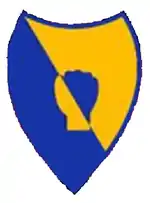 |
| 26th Aero Squadron emblem (Approved by AEF 18 November 1918)[3] | 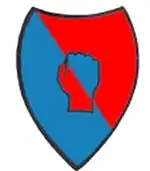 |
The mission of the 26th Space Aggressor Squadron is to replicate enemy threats to space-based and space-enabled systems during tests and training exercises. By using Global Positioning System and satellite communications jamming techniques, it provides Air Force, joint and coalition military personnel with an understanding of how to recognize, mitigate, counter and defeat these threats.
The 26th's tasks are to know, teach and replicate a wide array of terrestrial and space threats to the U.S. military's space enablers. The squadron trains the warfighter to operate in an environment where systems like GPS and SATCOM interfered with or denied—preparing them for the current and future fights.
History
Founded in 1914, the 26th is the oldest squadron[5] in the Air Force Reserve and one of the oldest in the United States Air Force. The squadron was organized as the 1st Reserve Aero Squadron on 26 May 1917, the first squadron of what would become the United States Air Force Reserve in 1948.
Origins
Elements of the squadron date to November 1915 when it was organized as part of the New York National Guard as the Aviation Detachment, First Battalion Signal Corps, New York National Guard, and shortly thereafter as the 1st Aero Company.
The 1st Aero Company was provisionally recognized by the federal government on 22 June 1916 and brought to U.S. service on 13 July 1916, with the objective of sending personnel and equipment to the 1st Aero Squadron in Mexico with the punitive expedition under General John J. Pershing. After being federalized, the company began training on 22 July at the new Mineola Signal Corps Aviation School under two Regular Army instructors assigned by the Signal Corps. The Army eventually trained 25 pilots but the 1st Aero Company was mustered out of federal service on 2 November 1916 without ever leaving Long Island, and was disbanded on 23 May 1917.
In the meantime, the National Defense Act of 1916, passed on 3 June, authorized an aviation section in the Signal Reserve Corps of 296 officers and 2,000 enlisted men as part of the Army's Aviation Section, U.S. Signal Corps. At Fort Jay, New York, attorney Phillip A. Carroll established the Governors Island Training Corps, a privately funded program to train civilians to pass the Reserve Military Aviator flying test and receive commissions in the Signal Officers Reserve Corps. The instructional program was under the guidance of the Army's Eastern Department, commanded by Major Gen. Leonard Wood, and trained seven civilians who were commissioned as Reserve Military Aviators.
World War I
After the United States' entry into World War I, the unit, less New York guardsmen and the new Reserve military Aviators were organized into a new unit at Mineola by Major Raynal Bolling and now-Captain Carroll. Federalized in June 1917, the 1st Reserve Aero Squadron trained during the summer of 1917 and sailed for Europe aboard the RMS Baltic on 23 August with eight other aero squadrons. Reaching France in Le Havre, on 17 September, it arrived at its duty station at Issoudun Aerodrome, home of the Third Aviation Instruction Center, on 21 September. After receiving further training in French schools in Pau and Tours Aerodrome until November, it assembled, serviced, and repaired aircraft. The 1st was redesignated as the 26th Aero Squadron on 1 October 1917 as part of a reorganization of the Air Service of the AEF. The 26th Aero Squadron left Issoudun on 13 April 1919, and remained in France until May 1919 when the unit returned to the United States and was demobilized.
Interwar period
The 26 Squadron (Attack) was authorized on 30 August 1921 and the following month was organized and assigned to the 3d Attack Group at Kelly Field, Texas. It was assigned various World War I era biplanes and experimental American aircraft of the 1920s, the squadron patrolled the Mexican Border, delivered airmail and performed other missions as assigned until inactivating in 1924, shortly after consolidating with the World War I 26th Aero Squadron.
The squadron was reactivated as the 26th Attack Squadron in Hawaii in 1930. It was equipped with Curtiss A-3 Falcons, which were used as fighter-bombers in the 1930s as part of the defense of the islands. Newer Douglas B-18 Bolos were assigned in late 1939, and the unit was redesignated as the 26th Bombardment Squadron. The B-18s were relegated to second-line patrol duty over the approaches to Oahu in 1941 after the Boeing B-17E Flying Fortresses arrived in Hawaii.
World War II
During the Pearl Harbor Attack, many of the squadron's aircraft were damaged at Hickam Field, and the survivors were reformed at Wheeler Field, where they were retained as part of the defense force of the territory under the new Seventh Air Force. The squadron deployed B-17s to Midway Island in late May 1942 to strengthen the island's defenses, however they were withdrawn prior to the Japanese attack on the airfield. They returned to Midway and attempted to raid the attacking Japanese naval forces with little success, and returned to Wheeler Field after the battle ended on 8 June.
The squadron deployed to the South Pacific and came under the new Thirteenth Air Force. Operating from the New Hebrides, the B-17s attacked enemy targets in the Solomon Islands during late 1942 as well as targets in New Guinea and other enemy-controlled areas in the South Pacific Area. The B-17s were flown to Australia from New Guinea in early 1943 and squadron personnel returned to Hawaii for re-equipping and replacement personnel. The squadron was re-equipped with very long range Consolidated B-24 Liberators optimized for long-range missions in the Pacific. The squadron operated in the Central Pacific Area flying very long-range heavy bombing missions over the Gilbert and Marshall Islands before moving west to Guam in the Northern Mariana Islands in October 1944. In 1945, Liberators from the squadron carried out very long range bombing attacks on Okinawa, eventually being stationed on Okinawa after the Japanese Capitulation in August 1945. In September 1945, immediately post-war, the planes were used to ferry former prisoners of war to Manila. The squadron was demobilized on Okinawa after the war, with aircraft being sent to the Philippines for reclamation. The 26th Bombardment Squadron still existed on paper as a Boeing B-29 Superfortress heavy bombardment squadron by Far East Air Forces until inactivation in late 1948, never being equipped or manned.
Strategic Air Command bomber operations
Reactivated under Strategic Air Command in December 1948 at Carswell Air Force Base, Texas, the squadron received the new Convair B-36B Peacemaker intercontinental strategic bomber. Upgraded to the jet-assisted B-36D in 1950, then the B-36J-III Featherweight in 1954. The squadron trained in heavy bombardment operations and participated in many SAC exercises and deployments. In 1958 moved to Altus Air Force Base, Oklahoma and was re-equipped with new Boeing B-52E Stratofortresses and continued operations as well as standing nuclear alert. Remained at Altus on alert status until B-52Es were phased out of SAC service and consigned to storage in 1968. Afterward the squadron was inactivated.
Fighter and aggressor operations
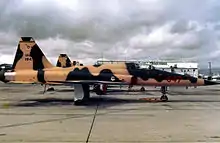
Reactivated under Pacific Air Forces (PACAF) at Clark Air Base, Philippines in 1973 with a training mission to provide dissimilar air combat training to PACAF fighter squadrons using Soviet-style fighter tactics. It was carried in non-operational status until the end of August 1975, by which time the 405th Fighter Wing had been replaced by the 3rd Tactical Fighter Wing at Clark. Even then, it did not start training activities until January 1976, using a number of Northrop T-38 Talon aircraft made surplus by the arrival of the Northrop F-5E Tiger IIs at Nellis Air Force Base, Nevada. Eventually, the squadron also received the F-5E, with some of the planes coming from stocks destined for the Republic of Vietnam Air Force but never delivered and an embargoed Ethiopian Air Force order. By that time it had been redesignated the 26th Tactical Fighter Training Squadron, and secondly as a Tactical Fighter Training and Aggressor Squadron. Eventually, it became the 26th Aggressor Squadron. The aggressor F-5Es were painted in a variety of colorful camouflage schemes designed to mimic those in use by Warsaw Pact aircraft. Two-digit Soviet-style nose codes were applied to most aggressor aircraft, and these coincided with the last two digits of the serial number. When there was duplication, three digits were used. Squadron was among the first to apply the star and bar in toned-down or stencil form.
By the late 1980s, the aircraft were becoming worn out after years of high-performance fighter training, with some aircraft being grounded for structural failures. In addition, the F-5E no longer could provide the training as a new generation of Soviet aircraft were becoming operational. The 26th at Clark was scheduled to dispose of its F-5Es in favor of General Dynamics F-16 Fighting Falcon and move to Kadena Air Base, Okinawa, in October 1988. The unit was minimally manned at Kadena while the squadron awaited new aircraft, flying a few borrowed aircraft from the 18th Tactical Fighter Wing. However, in 1990, the decision was made to terminate the entire USAF aggressor program. The 26th AS was inactivated on 21 February 1990 before it could receive its own F-16s.
Space aggressor unit
Reactivated under Air Force Space Command in 2003 as the 26th Space Aggressor Squadron as part of the 310th Space Wing at Schriever Air Force Base, Colorado. In 2007 the unit was reassigned to the 926th Group at Nellis and was transferred to Air Combat Command. However, the 26th remained at Schriever AFB, despite the organization as a geographically separated unit.
Lineage
- 26th Aero Squadron
- Organized as the 1st Reserve Aero Squadron on 26 May 1917
- Redesignated 26th Aero Squadron on 1 October 1917
- Demobilized on 7 June 1919
- Reconstituted and consolidated with the 26th Attack Squadron as the 26th Attack Squadron on 8 April 1924[1]
- 26th Space Aggressor Squadron
- Authorized as the 26th Squadron (Attack) on 30 August 1921
- Organized on 15 September 1921
- Redesignated 26th Attack Squadron on 25 January 1923
- Consolidated with the 26th Aero Squadron on 8 April 1924
- Inactivated on 27 June 1924
- Activated on 1 September 1930
- Redesignated 26th Bombardment Squadron Medium on 6 December 1939
- Redesignated 26th Bombardment Squadron Heavy on 11 December 1940
- Redesignated 26th Bombardment Squadron, Heavy c. 3 August 1944
- Redesignated 26th Bombardment Squadron, Heavy on 30 April 1946
- Inactivated on 20 October 1948
- Redesignated 26th Bombardment Squadron, Heavy and activated on 1 December 1948
- Discontinued and inactivated on 2 July 1968
- Redesignated 26th Tactical Fighter Squadron on 24 September 1973
- Activated on 30 September 1973
- Redesignated 26th Tactical Fighter Training Squadron on 31 August 1975
- Redesignated 26th Tactical Fighter Training Aggressor Squadron on 30 November 1977
- Redesignated 26th Aggressor Squadron on 22 April 1983
- Inactivated on 21 February 1990
- Redesignated 26th Space Aggressor Squadron on 21 February 2003
- Activated in the reserve on 1 October 2003[1]
Assignments
- Eastern Department, 26 May 1917
- Third Aviation Instruction Center, c. September 1917
- Unknown, April–7 June 1919
- 3d Attack Group, 15 September 1921 – 27 June 1924
- 5th Composite Group (later 5 Bombardment Group), 1 September 1930 (attached to 18th Pursuit Group)
- 18th Wing, 12 October 1938 (attached to 18th Pursuit Group until c. 10 December 1939)
- 11th Bombardment Group, 1 February 1940 – 20 October 1948
- 11th Bombardment Group, 1 December 1948 (attached to 11th Bombardment Wing after 16 February 1951)
- 11th Bombardment Wing (later 11th Strategic Aerospace Wing), 16 June 1952 – 2 July 1968
- 405th Fighter Wing, 30 September 1973
- 3d Tactical Fighter Wing, 16 September 1974
- 18th Tactical Fighter Wing, 1 October 1988 – 21 February 1990
- 310th Space Group, 1 October 2003[1]
- 926th Group (later 926th Wing), 17 August 2007 – present[6][7]
Stations
|
|
Aircraft
- Dayton-Wright DH-4, 1921-1924
- Included various experimental models including the "flying tank," 1921-1924
- Curtiss A-3 Falcon, 1930–1936
- Boeing PW-9, 1931
- Curtiss A-12 Shrike, 1936–1939
- Douglas B-18 Bolo, 1940–1942
- Boeing B-17 Flying Fortress, 1941–1943
- Consolidated B-24 Liberator, 1943–1945
- Convair B-36 Peacemaker, 1949–1957
- Boeing B-52 Stratofortress, 1958–1968
- Northrop T-38 Talon, 1975–1980
- Northrop F-5E Tiger II, 1977–1988
- Lockheed T-33 T-Bird, 1986–1987
- McDonnell Douglas F-15 Eagle (borrowed), 1988-1989
- General Dynamics F-16 Fighting Falcon (borrowed), 1988-1989[1]
Campaigns
Decorations
- Distinguished Unit Citation South Pacific, 31 July-30 November 1942
- Navy Presidential Unit Citation Pacific Theater, 7 August-9 December 1942
- Air Force Outstanding Unit Awards:
- 6 August 1954 – 15 July 1957
- 27 October 1958 – 16 September 1960
- 1 May 1980 – 30 April 1982
- 22 March-1 April 1986
- 1 June 1987 – 31 May 1989[1]
References
Notes
- Explanatory notes
- The aircraft is General Dynamics F-16C Block 30K serial 88-403.
- F-5E serial 73-847 in the foreground was originally scheduled for shipment to the Republic of Vietnam Air Force, however the aircraft was retained by the USAF after the collapse of the South Vietnamese government in 1975. With the inactivation of the 26th, this aircraft was sold to the Honduran Air Force.
- Citations
- Endicott, Judy G. (7 January 2008). "Factsheet 26 Space Aggressor Squadron (AFRC)". Air Force Historical Research Agency. Retrieved 15 April 2018.
- Maurer, Combat Squadrons, pp. 133–134
- "World War I Aero Squadrons". Cross and Cockade Journal. Society of World War I Aero Historians. 5 (2): 145. 1964.
- McWhorter, Capt Karin (26 October 2007). "Nellis activates 926th Reserve Group". Nellis AFB Public Affairs. Archived from the original on 5 March 2012. Retrieved 16 April 2018.
- "Oldest Reserve squadron receives 81st commander". 310th Space Wing. Retrieved 10 July 2022.
- Research Division, Air Force Historical Research Agency, Air Force Organization Change Status Report, August 2007, Maxwell AFB, AL
- Bailey, Carl E. (10 December 2014). "Factsheet 926 Wing (AFTC)". Air Force Historical Research Agency. Archived from the original on 4 March 2016. Retrieved 17 January 2017.
Bibliography
![]() This article incorporates public domain material from the Air Force Historical Research Agency.
This article incorporates public domain material from the Air Force Historical Research Agency.
- Maurer, Maurer, ed. (1983) [1961]. Air Force Combat Units of World War II (PDF) (reprint ed.). Washington, DC: Office of Air Force History. ISBN 0-912799-02-1. LCCN 61060979. Retrieved 17 December 2016.
- Maurer, Maurer, ed. (1982) [1969]. Combat Squadrons of the Air Force, World War II (PDF) (reprint ed.). Washington, DC: Office of Air Force History. ISBN 0-405-12194-6. LCCN 70605402. OCLC 72556. Retrieved 17 December 2016.
- Morse, Stan; Donald, David (1992). US Air Force Air Power Directory. Airtime Publishing. ISBN 978-1-880588-01-7.
- Ravenstein, Charles A. (1984). Air Force Combat Wings, Lineage & Honors Histories 1947-1977. Washington, DC: Office of Air Force History. ISBN 0-912799-12-9. Retrieved 17 December 2016.
- Rogers, Brian (2005). United States Air Force Unit Designations Since 1978. Ian Allan Publishing. ISBN 978-1-85780-197-2.

